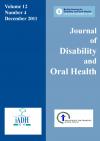Journal of Disability and Oral Health

- Cover Date:
- December 2011
- Print ISSN:
- 1470-8558
- Vol:
- 12
- Issue:
- 4
Editorial - Research in Special Care Dentistry
The definition of Special Care Dentistry (SCD) is broad and the transitional period for joining the specialist list at the GDC in the UK demonstrated the huge diversity in the day to day clinical practice of specialists. Some practitioners work almost exclusively with particular patient groups while others, especially those working in community settings, have a broader portfolio of patients with special care dental needs. There is a requirement for a broad clinical home for people with special care dental needs, but the diversity of needs presents a challenge, because it makes SCD outcomes difficult to define. ‘Onesize fits all’ outcomes of care are inappropriate. Across the UK there is an ever dwindling pot of money allocated to NHS dentistry and we are exhorted almost daily to do more for less. Our international colleagues in IADH report similar pressures. It will be important that we work to protect services for people with special care dental needs. Assessing the outcomes of care can no longer be seen as something which is separate from our everyday clinical practice. In a time of austerity measuring outcomes has to be an integral part of what we do and services which cannot demonstrate effectiveness face being curtailed or withdrawn. Competition is fierce particularly when we compete with services that are considered a higher priority than dental care. In making the case for SCD we need to show that what we do represents good value for money and is of high quality, and at the same time the service needs to be flexible and responsive to people living with disabilities and other vulnerable groups. It is vitally important that we provide robust evidence of the effectiveness of our dental care. This means to paraphrase Sackett: the ‘right’ treatment, to the ‘right’ patient, by the ‘right’ person in the most appropriate ‘right’ setting. The characteristics of the care provided and the patient experience must also be ‘right’ and includes: respect for choice, dignity, satisfaction, empowerment and inclusion in decisions about care (DOH 2007). Dental attendance alone will not prevent oral and dental diseases: its main aim is to manage disease once it has occurred and minimise the consequences to the individual. Regular and appropriate attendance is important as it allows the dental team the opportunity to provide timely, high quality care, and to support people to develop positive oral health behaviours. We can never simply treat away the causes of dental disease (Blinkhorn, 1998), and simply fixing people up to return to the conditions which created their problems is shortsighted and possibly a waste of resources. In order to prevent oral disease we need to have a more holistic view of our patients. If people are to adopt positive oral health behaviours, they
need to live in healthy, supportive environments, which allow them to realise their potential and provide opportunities to make healthy choices (DOH, 2005). High quality dental care with a focus on prevention must be complemented at a community level by targeted oral health promotion for people with special care dental needs. This essential aspect of SCD is often underplayed or neglected. Those of us who advocate its importance must also be prepared to submit to an assessment of its effectiveness and value for money. BSDH has been at the forefront of producing well regarded, best practice guidelines on clinical care in SCD, but the paucity of the evidence base supporting these guidelines is problematic. There are few examples of high quality randomised controlled trials or of systematic reviews in the field of SCD. It is also apparent from a quick review of recent literature that the voices and concerns of people living with disabilities and other vulnerable groups are rarely reported. There are several reasons for the lack of research in SCD. • Currently (and historically) most SCD is delivered by busy dental teams in situations where there is little support or time for clinical research. Examples of good practice may not be written up for publication because clinicians feel they lack the time, or because their case loads of the more unusual conditions are too small, or because they feel that they lack the skills to undertake research and are isolated from academic centres who could help. There is a perception that patients don’t like getting involved in research, but experience elsewhere shows that if the purpose of the research is clearly explained to patients, many are willing to participate, particularly as it might benefit others with a similar condition.
•
The result is that many excellent examples of innovation have not been adopted because the outcomes could not be determined due to faulty research design. But our medical colleagues also face these challenges yet manage an impressive research output and they, like us, deal with medically complex and challenging patients. It is clear that there is an urgent need to develop research skills within the dental team working at the sharp end. So how might this be taken forward? One way of doing this in the short term might be to develop local research networks supported by research mentors and regional research co-ordinators from amongst the BSDH membership. Developing local research networks amongst clinical practitioners is a model that has been used successfully in Scandinavia, the US (Pearl, PBRN, NW Precedent networks) and in the UK (the Faculty of General Dental
- Article Price
- £15.00
- Institution Article Price
- £
- Page Start
- 146
- Page End
- 147
- Authors
- B Daly
Articles from this issue
- Title
- Pg. Start
- Pg. End
- Influence of command on tongue elevation during swallowing: examination of tongue pressure and ultrasound imaging
- 149
- 158
